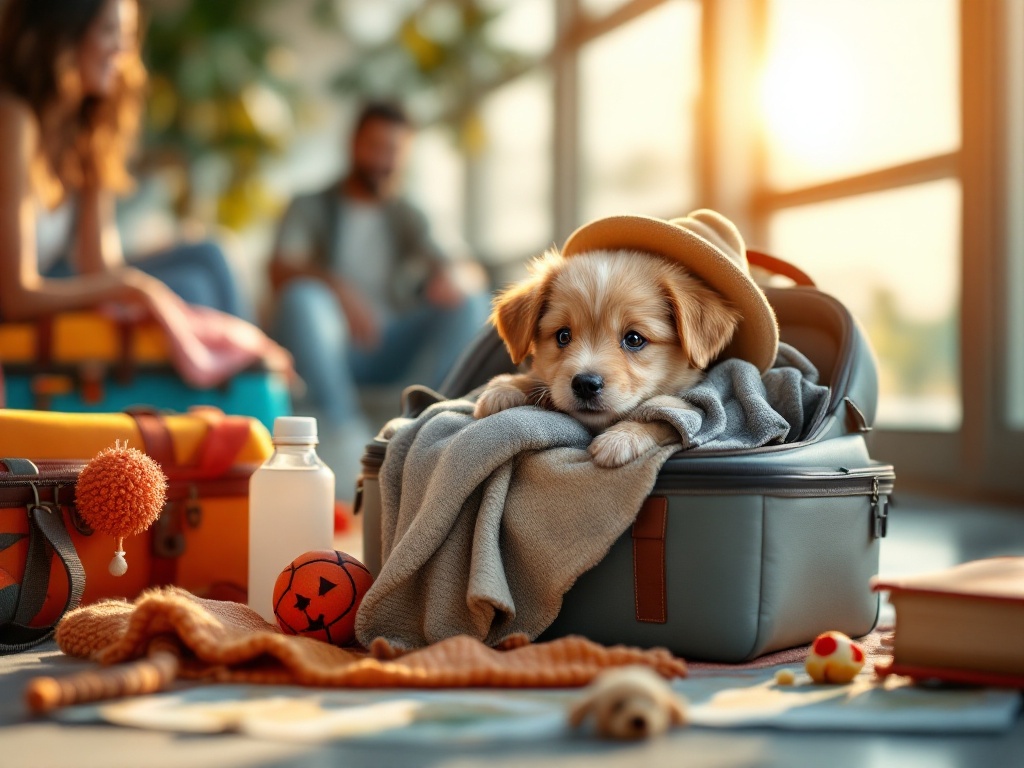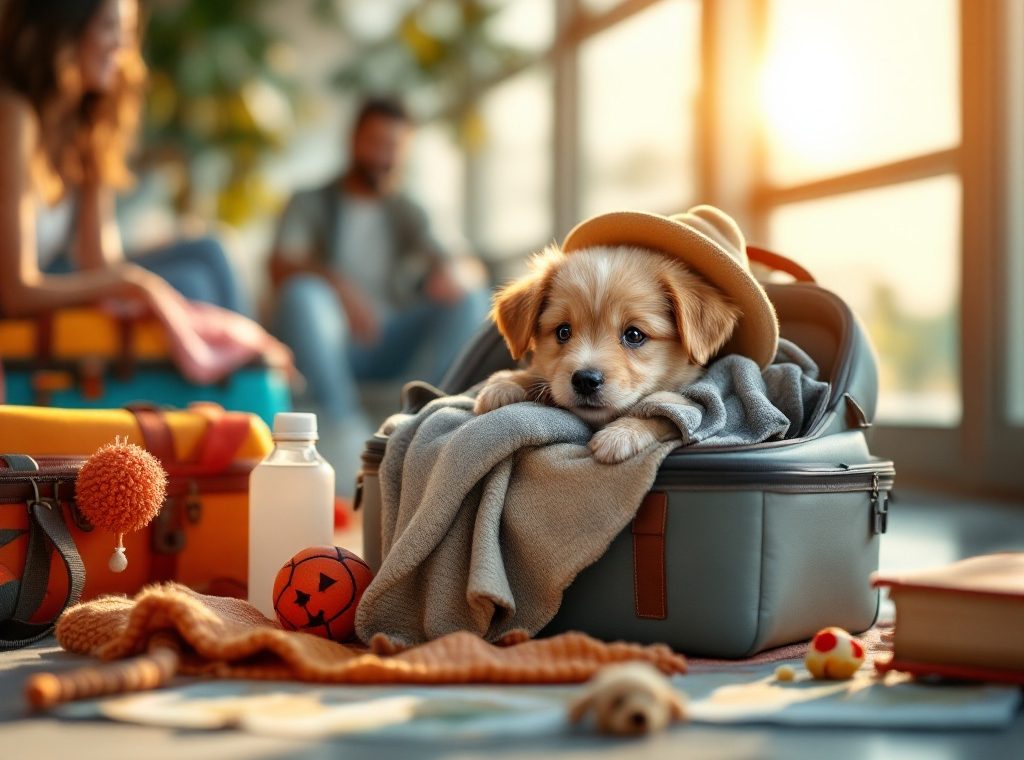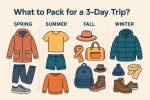Is Traveling with a Puppy a Good Idea? What You Need to Know
Dreaming of adventures with your furry friend? Discover how to make traveling with your puppy a joyful experience! Learn crucial tips, from essential vaccinations and airline-approved carriers to managing car sickness and ensuring safety in unfamiliar environments. Prepare for a smooth and rewarding journey with our comprehensive guide – ensuring happy travels for both of you. Start planning your puppy’s first adventure today!
Important information

- Consult your vet: Ensure your puppy is healthy to travel, has required vaccinations, and discuss potential car sickness remedies.
- Plan and prepare: Book pet-friendly accommodations in advance, research airline pet policies if flying, and pack essentials like food, water, bowls, leash, collar with ID, medications, waste bags, a familiar toy or blanket, and travel documents.
- Prioritize safety: Crate train your puppy for a secure travel experience. Never leave your puppy unattended in a hot car. Secure your puppy with a harness or carrier during car travel.
- Manage stress and anxiety: Introduce travel gradually with short trips. Bring familiar items for comfort. Use positive reinforcement and rewards. Avoid overwhelming environments like busy rest stops or crowded airports.
- Potty breaks and cleanliness: Plan frequent potty breaks every 2-3 hours during car trips. Carry waste bags and disinfectant wipes for cleanups. Avoid common dog potty areas until vaccinations are complete.
Is Traveling with a Puppy a Good Idea?
Traveling with a puppy can be a rewarding experience, fostering early socialization and strengthening your bond. Careful planning is crucial for a smooth trip. Consider your puppy’s age, health, and temperament, as well as the travel conditions and mode of transportation. With proper preparation, you can ensure a safe and enjoyable journey for both you and your furry companion. Here’s what you need to consider:
Puppy’s Age and Health. Consult your veterinarian to ensure your puppy is healthy enough for travel and up-to-date on necessary vaccinations.
Temperament and Training. A well-behaved puppy will make travel easier. Basic obedience training and crate training can be beneficial.
Mode of Transportation. Consider the length of the trip and your puppy’s comfort level when choosing between car, train, or plane.
Travel Destination. Research pet-friendly accommodations, parks, and activities at your destination.
Essential Supplies. Pack food, water, bowls, leash, collar with ID tags, medications, waste bags, a familiar toy or blanket, and any necessary travel documents.
Benefits of Traveling with a Puppy
Traveling with your puppy creates wonderful shared adventures and strengthens your bond. Early exposure to new environments is crucial for socialization, helping your pup become a well-adjusted adult by encountering diverse sights, sounds, and smells. Travel also presents excellent training opportunities, reinforcing known commands and encouraging positive behavior in new situations. These journeys offer invaluable learning experiences for your furry friend.
Challenges and Considerations
Traveling with a puppy can be challenging. Here’s what you need to consider:
Frequent potty breaks are essential for puppies. Plan for more stops than you would with an adult dog.
Potential car sickness can be an issue. Consult your vet about medication and provide a comfortable, well-ventilated travel crate.
Pet-friendly accommodations are a must. Book in advance and confirm their pet policies.
Managing anxiety in unfamiliar surroundings is crucial. Bring familiar toys and bedding to comfort your puppy.
Flexibility is key for a smooth journey. Be prepared to adjust your plans as needed.
Puppy Preparation for Travel
Consult your veterinarian about necessary vaccinations and region-specific health risks. Obtain the required health certificates and any preventative medications for your destination.
Crate training offers a safe and secure travel experience. A properly sized crate prevents injuries and provides a familiar, comforting space. For car travel, secure your puppy with a dog harness or seatbelt.
Introduce travel gradually to minimize anxiety. Short car trips or acclimating your puppy to their carrier for plane travel can be beneficial. Practicing basic commands helps maintain control in unfamiliar environments.
Pack essential supplies, including food, water, a collapsible bowl, a leash, and waste bags. Comfort items like toys and a blanket can ease stress, while cleaning supplies are essential for dealing with potential accidents.
Essential Vaccinations and Health Checks
Core puppy vaccines protect against serious diseases like distemper, parvovirus, and rabies. Your veterinarian may recommend additional vaccines depending on your lifestyle and environment, such as those for Bordetella, canine influenza, or Leptospirosis. A health certificate from your veterinarian confirms your puppy’s health and vaccination status. This certificate is usually required for air travel and may also be requested by other transportation services or pet-friendly accommodations. Always check the specific requirements of your destination or chosen services to ensure a smooth and safe trip for your puppy.
Crate Training and Safety Measures
Traveling with Your Puppy: A Guide to Safe and Comfortable JourneysCrate training is essential for safe and comfortable puppy travel. It provides a secure, familiar space that reduces anxiety during car rides and flights, while also preventing accidents.
Start crate training well in advance of your trip. Practice significantly reduces travel anxiety.
Never leave your puppy unattended in a hot car. This can be life-threatening.
Secure your puppy with a crate or harness during car travel. Do not allow them to hang their head out the window, as it’s dangerous.
Consider a GPS tracker for added safety.
When exploring new environments, exercise caution around other dogs until your puppy’s vaccinations are complete. This protects their health.
Familiarization with Travel Environment
Introduce your puppy to car travel gradually by letting them explore the vehicle. A travel crate can enhance their comfort and safety. For future flights, acclimate your puppy to the airport environment beforehand. A brief visit, without actually flying, exposes them to the sights and sounds, minimizing stress for smoother future air travel.
Start with short car rides, gradually increasing the duration to help your puppy adjust to the motion and sounds of car travel.
Make the experience positive by associating it with rewards, praise, and their favorite toys or blankets.
If your puppy experiences car sickness, consult your veterinarian for advice and potential remedies.
Gathering Travel Essentials
Traveling with your pet? Don’t forget these essentials:
- Airline-approved carrier: if flying, a comfortable carrier is a must for your pet’s safety and comfort.
- Secure harness or seatbelt: for road trips, prioritize safety with a secure car restraint.
- Calming supplements: consider calming supplements to help ease travel anxiety.
- Food, water, bowls, leash, and waste bags: pack the basics to keep your pet fed, hydrated, and comfortable.
- Medications and vaccination records: ensure you have necessary medications and proof of vaccinations.
- Favorite toy or blanket: bring a familiar item to provide comfort and reduce stress.
- Pet first-aid kit: be prepared for unexpected situations with a well-stocked first-aid kit.
Car Travel with a Puppy
Traveling with Your Puppy: Tips for a Smooth RideExercise your pup before a car trip to help them relax during the journey. Secure them with a car harness or seatbelt to prevent injuries during sudden stops. If your puppy experiences car sickness, consult your vet about medications or remedies. Maintain a comfortable car temperature, avoiding extremes. On long trips, plan potty breaks for your puppy’s comfort and to prevent accidents.
Exercise Before Traveling
A tired puppy is a well-behaved traveler. Before a long car ride or flight, exercise your pup to help them relax and reduce travel anxiety. Even a short walk or quick play session can significantly improve their travel experience, making for a smoother journey for everyone.
Using a Dog Harness or Seatbelt
Secure your puppy’s safety during car trips with a harness, seatbelt, or crate. This protects your pet and allows you to focus on driving.
Managing Car Sickness
Before traveling, fast your puppy for a few hours and ensure good car ventilation for their comfort. Begin with short drives to acclimate your puppy to the car, gradually increasing the distance. If car sickness persists, consult your veterinarian about medication. The issue might be anxiety, not motion sickness, so distinguishing between the two is crucial. Here’s a step-by-step guide to help your puppy enjoy car rides:
Fast your puppy. Fasting your puppy for a few hours before the trip can help prevent car sickness.
Ensure good ventilation. Provide good car ventilation to keep your puppy comfortable.
Start with short trips. Begin with short drives to get your puppy used to the car.
Gradually increase distance. Slowly increase the length of the car rides as your puppy becomes more comfortable.
Consult your vet if needed. If car sickness continues, talk to your veterinarian about possible medication.
Consider anxiety. Keep in mind that the problem could be anxiety-related, not motion sickness.
Temperature Regulation and Comfort
Traveling with a young puppy requires careful attention to their comfort and safety, especially regarding temperature regulation. Puppies are susceptible to overheating, so maintaining a comfortable car environment is essential. Regularly monitor the temperature inside your vehicle to prevent overheating, which can be dangerous for young puppies. Providing familiar scents, such as blankets or clothing from home, can help reduce stress during the journey. Frequent breaks for water and puppy wellness checks are crucial for a safe and pleasant trip.
Scheduling Frequent Potty Breaks
On car trips, plan potty breaks for your puppy every two to three hours, as their smaller bladders necessitate more frequent stops than adult dogs. While airports and rest stops often provide pet relief areas, carrying extra pee pads is a wise precaution for emergencies.
Air Travel with a Puppy
Traveling with your puppy can be a breeze with a little planning. Start by researching airline pet policies. Contacting the airline directly is best to confirm their specific requirements for size, breed, age, and necessary health documentation. Most airlines will require a health certificate from your veterinarian, so schedule a visit in advance. Also, be sure to check for any required documents and carrier specifics.Choosing the right carrier is crucial. Select an airline-approved, well-ventilated carrier that allows your puppy enough room to stand, turn around, and lie down comfortably. Ensure it’s leak-proof and secure for a safe journey. It’s a good idea to let your puppy acclimate to the carrier before the flight.Proper feeding is also essential. Avoid feeding your puppy right before the flight to prevent car sickness or accidents during travel. Consult your vet about the best feeding schedule for your puppy’s age and breed. At the airport, minimize your puppy’s exposure to other animals to reduce stress in the unfamiliar environment. Keep your puppy leashed and avoid overwhelming situations. With these preparations, your puppy’s flight can be safe, comfortable, and enjoyable.
Understanding Airline Pet Policies
Traveling with your pet requires careful planning, as airline pet policies vary significantly. Contact the airline directly to confirm their specific requirements for pet travel. Here’s a general overview of what to expect:
Age and Breed Restrictions
Some airlines impose age restrictions on traveling pets, particularly for puppies or kittens. Certain breeds may also be restricted due to health concerns, especially brachycephalic (short-nosed) breeds.
Required Documentation
Airlines often require health certificates from a veterinarian, confirming your pet’s fitness to fly. Additional documentation may be necessary depending on your destination.
Approved Carriers
Airlines have specific regulations regarding pet carriers, including size, ventilation, and construction materials. Check with your chosen airline for their approved carrier dimensions and guidelines.
Booking in Advance
Book your pet’s spot simultaneously with your flight reservation. Space for animals is often limited, and booking in advance is crucial to secure a spot for your furry companion.
Airline-Approved Carrier Requirements
Traveling with your pet requires a carrier that meets airline regulations for a comfortable journey. These regulations cover size, ventilation, and a leak-proof design, ensuring your pet has enough space to stand, turn around, and lie down comfortably. Check with your chosen airline for their specific requirements, as size limits and approved materials vary. For example, Southwest Airlines has strict size restrictions for hard-sided in-cabin kennels: 17.5 inches long, 10 inches wide, and no taller than 9.5 inches.
Feeding Schedule Before Flights
Withhold solid food from your puppy about four hours before your flight to prevent potential digestive issues. Ensure they have access to water, as hydration is crucial.
Socialization Opportunities at the Airport
Taking your puppy to the airport provides excellent socialization opportunities. The bustling environment, filled with new sights, sounds, and smells, helps your puppy adapt to unfamiliar situations. Meeting a variety of people builds their confidence and reduces potential anxiety later in life, contributing to a well-adjusted and happy companion.
Managing Stress and Safety During Travel
Traveling with a puppy can be daunting, but a few simple steps can ensure a safe and comfortable trip for both of you.
Consult your vet about calming supplements or pheromone sprays to ease your puppy’s anxiety. A familiar blanket or toy carrying your scent can also offer comfort.
Skip busy rest stops and crowded airports, which can easily overwhelm your puppy. Instead, seek out quieter areas for breaks.
For car travel, secure your puppy in a properly sized carrier or crate. A dog harness or seatbelt adds an extra layer of safety.
Frequent potty breaks are crucial. Lining the carrier with absorbent pads can prevent accidents.
Positive reinforcement and rewards will help your puppy build positive associations with travel. Most importantly, stay calm and reassuring; your demeanor significantly impacts your puppy’s sense of security, making the journey more enjoyable for everyone.
Using Calming Supplements
Traveling can be stressful for puppies, but calming supplements can help. Consult your veterinarian for advice on the appropriate supplement and dosage for your puppy’s size and age. Some options may require a prescription for more serious anxiety.
Avoiding Overwhelming Environments
Loud noises and large gatherings can easily overstimulate your puppy. It’s best to introduce new environments gradually. A quiet, secure den is vital, offering a comforting retreat like a crate where your puppy can relax and de-stress.
Preventing Potty Accidents
Crate-training your puppy at night helps prevent accidents and teaches bladder control. Frequent potty breaks are crucial, as puppies need them more often than adult dogs. Ensure the crate is appropriately sized: large enough for your puppy to stand and turn around, but not so big that they can have an accident in a corner.
Until your puppy’s vaccinations are complete, avoid areas with other dogs, such as busy dog parks, to protect them from diseases like parvo.
Never leave your puppy alone in a car, especially in extreme temperatures, as the interior can quickly become dangerous. When possible, plan potty breaks in less-frequented areas. This minimizes contact with other dogs and provides a cleaner environment.
Bonding and Positive Reinforcement
Traveling with your puppy can deepen your connection. Positive reinforcement, like praise and treats, makes car rides enjoyable and builds your pup’s confidence, creating a safe and happy travel experience.
Arriving at Your Destination
Traveling with Your Puppy: A Guide to a Smooth TripFinding pet-friendly accommodations is essential for a stress-free trip. Look for hotels or rentals that openly welcome pets. Before booking, carefully review their pet policies, including fees and any breed or size restrictions. Help your puppy adjust to new environments. Start with short, leashed walks to familiarize them with their surroundings. Show them where their food and water will be. Bringing familiar toys can provide comfort during the transition. Potty breaks require extra attention. Closely supervise your puppy in shared spaces, watching out for hazards like broken glass or other animal droppings. Monitor their interactions with other animals, as even a friendly encounter can sometimes become unpleasant. With careful supervision, your puppy can safely enjoy new experiences.
Find pet-friendly accommodations. Look for hotels or rentals that openly welcome pets.
Review pet policies. Before booking, carefully check for any fees, breed, or size restrictions.
Help your puppy adjust. Start with leashed walks to familiarize them with the new environment and show them their designated food and water areas.
Supervise potty breaks. Watch out for hazards like broken glass or other animal waste in shared spaces.
Monitor interactions. Keep a close eye on your puppy’s interactions with other animals to ensure peaceful encounters.
Identifying Pet-Friendly Accommodations
Traveling with your pet can be a breeze with the right preparation. Many accommodations welcome furry friends, offering amenities such as dog parks, pet-sitting services, and nearby trails for enjoyable walks. Before booking, confirm pet policies, including any fees or restrictions, with your chosen hotel or rental. Opt for spacious accommodations that provide both a comfortable and safe environment for your pet to relax and explore.
Acclimating Your Puppy to New Areas
Help your puppy settle in by exploring your home together on a leash. Show them their food and water bowls, and their comfy new bed. Familiar toys and blankets will offer comfort and reduce stress. Remember to puppy-proof the area beforehand, checking for hazards like toxic plants and loose wires.
Explore your home together on a leash.
Show your puppy their food and water bowls, and their new bed.
Provide familiar toys and blankets for comfort.
Puppy-proof the area, checking for hazards like toxic plants and loose wires.
Ensuring Safety in Common Potty Areas
Keep your puppy safe by avoiding common dog potty areas like dog parks, which pose a high risk of disease, especially for puppies with incomplete vaccinations. Young puppies are particularly vulnerable to parvovirus and other illnesses. Choose isolated spots for potty breaks to minimize their exposure. Always carry disinfectant wipes or spray for quick and essential cleanups after your puppy eliminates.










